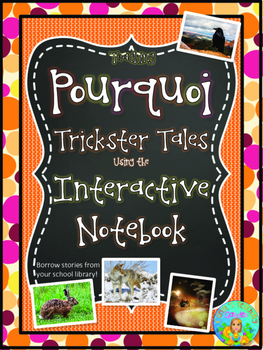Teaching Pourquoi Trickster Tales Using the Interactive Notebook
Carol's Garden
918 Followers
Grade Levels
3rd - 6th
Resource Type
Standards
CCSSRL.3.2
CCSSRL.3.4
CCSSRL.3.9
CCSSRL.3.10
CCSSRL.4.4
Formats Included
- PDF
Pages
16 pages
Carol's Garden
918 Followers
Description
Pourquoi stories, or trickster tales as they are sometimes called, are told by many cultures around the world. Many Native American tribes tell stories about lazy rabbits, clever coyotes, or intelligent ravens who trick other animals or beings into getting what they want, or not. These stories tell “why” something in the natural world exists in the way it does. Most of them include morality lessons for children listening to the stories.
Help your students learn about pourquoi stories in order to write trickster tales of their own. Children enjoy using their imaginations and they will love the opportunity to write about animals in a fun, interesting way.
In this set you will receive:
Unit cover
Directions for using pourquoi stories in your classroom, including a detailed lesson plan for reading and writing.
Two blank graphic organizers for use with interactive notebooks, one for reading the stories, and another for students to create their own
Examples of a finished set of graphic organizers, filled out by reading three suggested pourquoi stories
Envelope for holding vocabulary cards in an interactive notebook
Two-sided vocabulary cards (8 to a sheet) with space for the term, definition, drawing, and a sentence using the term
Please note that no pourquoi stories are included in this product. You will need to borrow them from your school or local library.
If you would like to see my other products, please click on my store name. Follow me to receive notice of new products, flash freebies, and sales!
You might also enjoy my other Interactive Notebook items:
Interactive Notebook Lessons
Help your students learn about pourquoi stories in order to write trickster tales of their own. Children enjoy using their imaginations and they will love the opportunity to write about animals in a fun, interesting way.
In this set you will receive:
Unit cover
Directions for using pourquoi stories in your classroom, including a detailed lesson plan for reading and writing.
Two blank graphic organizers for use with interactive notebooks, one for reading the stories, and another for students to create their own
Examples of a finished set of graphic organizers, filled out by reading three suggested pourquoi stories
Envelope for holding vocabulary cards in an interactive notebook
Two-sided vocabulary cards (8 to a sheet) with space for the term, definition, drawing, and a sentence using the term
Please note that no pourquoi stories are included in this product. You will need to borrow them from your school or local library.
If you would like to see my other products, please click on my store name. Follow me to receive notice of new products, flash freebies, and sales!
You might also enjoy my other Interactive Notebook items:
Interactive Notebook Lessons
Total Pages
16 pages
Answer Key
N/A
Teaching Duration
3 days
Report this resource to TPT
Reported resources will be reviewed by our team. Report this resource to let us know if this resource violates TPT’s content guidelines.
Standards
to see state-specific standards (only available in the US).
CCSSRL.3.2
Recount stories, including fables, folktales, and myths from diverse cultures; determine the central message, lesson, or moral and explain how it is conveyed through key details in the text.
CCSSRL.3.4
Determine the meaning of words and phrases as they are used in a text, distinguishing literal from nonliteral language.
CCSSRL.3.9
Compare and contrast the themes, settings, and plots of stories written by the same author about the same or similar characters (e.g., in books from a series).
CCSSRL.3.10
By the end of the year, read and comprehend literature, including stories, dramas, and poetry, at the high end of the grades 2–3 text complexity band independently and proficiently.
CCSSRL.4.4
Determine the meaning of words and phrases as they are used in a text, including those that allude to significant characters found in mythology (e.g., Herculean).





